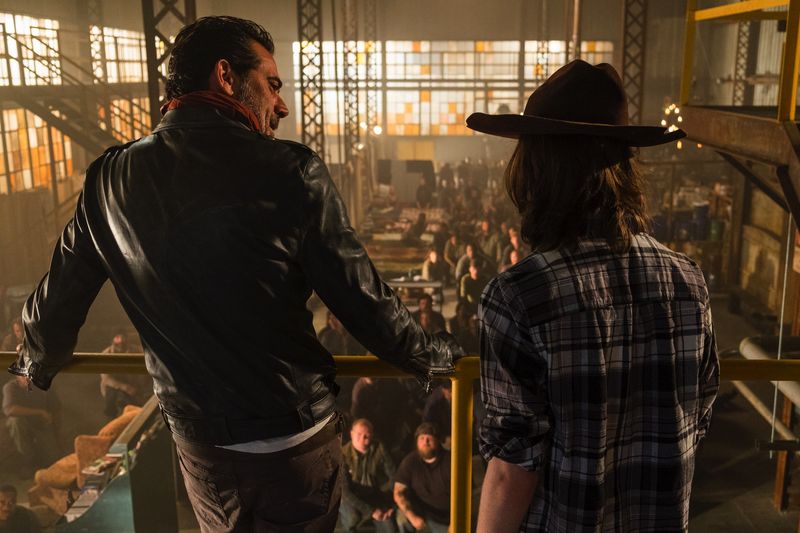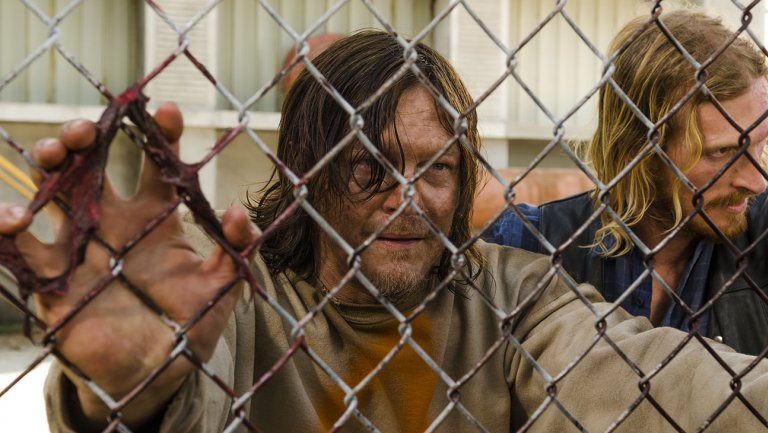-
Recent Posts
- Better Call Saul: There Are No Happy Endings between a “Rock and Hard Place”
- Black Widow Keeps It in the Family for Natasha’s Last Ride
- Loki Finds New Purpose in the Man behind the Mischief
- In its Debut, Star Wars: The Bad Batch Decides Whether to Obey or Rebel
- Nomadland: A Film Out of Time, For Our Times
Archives
Recent Comments
- Ed Clarke on Contact
- Matt on Why “The Frying Game” Is a Dark Horse Contender for The Simpsons’s Worst Episode Ever
- Lilly Dow on Contact
- Stacey on Veep’s Series Finale and the Hollowness of Getting What You Want
- Evan Jaocbs on Contact
Meta
Tag Archives: Negan
The Walking Dead Ponders the Same Old Moral Quandaries in “The Lost and the Plunderers”
I’m not the first person to suggest that The Walking Dead has exhausted itself creatively. Eight years in, almost any show is going to have trouble feeling vibrant and fresh. But what’s conspicuous about “The Lost and the Plunderers” is how clearly it evinces the sense of a late era version of this show — a show that’s always tried to aim a bit higher than its grindhouse roots — that’s running out of meaningful things to say.
The Walking Dead Warns This Is “How It’s Gotta Be” in a Trying Mid-Season Finale

If you’re a Walking Dead fan who’s made it this far, you’ve gone through a lot. As someone who watched that first fateful episode on Halloween nearly eight years ago, it’s easy to feel, in a weird way, like you’re one of the survivors from the show. After all, you’ve stuck this thing out, experienced good stretches and bad stretches, while more and more of your friends and acquaintances drop out, many of them resigned to the fact that things can never go back to how they used to be.
The Walking Dead Has Good Ideas and Bad Dialogue in “Time for After”
The continued struggle of The Walking Dead is remarkably consistent. The show’s unhurried pace often gives it time to delve deeply into the theme of the week and really chew on it rather than just gulping it down and moving on like the eponymous, ravenous zombies who populate the series. Sure, some episodes are little more than epic climaxes or piece-moving adventures, but for the most part, even the worst episodes of the show have something they’re trying to say and some idea they’re trying to dig into.
But the show is almost impressively bad at crafting the sort of dialogue for its characters that can ground those examinations in something that feels like real human experience and interactions.
The Walking Dead Shows Negan as a True Believer and a Leviathan in “The Big Scary U”
“A war of all against all.” That’s how philosopher Thomas Hobbes pithily explained the “state of nature,” his theoretical account of what it was like when human beings lived without government, without order, and without rule. He imagined a life that was “nasty, brutish, and short” and posited that we all needed a Leviathan, the personification of the force and power of the government, to avoid that unenviable existence. On Hobbes’ account, people needed to give up certain freedoms and turn things over to the Leviathan to ensure compliance with the order of the day, as the price to avoid that endless, indiscriminate war.
In Negan’s mind, he is that Leviathan. The last time The Walking Dead interrogated Negan’s moral philosophy, it left it ambiguous how the leader of The Saviors viewed himself. It was nebulous whether Negan really believed that his brutal ways were for the greater good, or whether he was just spinning propaganda to justify the comparatively lavish and carefree lifestyle he could enjoy while others toiled.
“The Big Scary U” is much less ambiguous. There is a certain sense that Negan may be deluding himself, offering rationalizations and eliding the darker or more self-serving side of the choices he’s made. But it nevertheless becomes clear that, on the surface at least, he is a true believer, someone who thinks that he’s doing what needs to be done to avoid a worse fate for everyone.
The Walking Dead Imagines What the Future Looks Like in “Mercy”

Someday, The Walking Dead will end. Sure, with this premise, the folks in charge could theoretically cycle through cast members like Saturday Night Live and go on into eternity. But the practical reality is that, as the show begins its eighth season, it’s likely closer to its end than its beginning.
But it’s hard to imagine what that ending will look like. Comic book creator Robert Kirkman famously declared that his story could go on forever and that he had no clear ending in mind. The recent Robot Chicken special poking fun at the show envisioned a relatively normal future where society has been rebuilt and there’s a Walker Museum devoted to the struggle of the series (with a nice “historical game of telephone” vibe). Others have speculated about who might survive to the end, whether anyone will find a cure, and how a new civilization comes to fruition. Still, there’s no obvious place for this story to end, no clear way to reach a series-length measure of catharsis.
The Walking Dead: The Division and Reunion in “Hearts Still Beating”

Since at least the middle of the show’s fourth season, The Walking Dead’s M.O. has been to divide and conquer. As the show’s cast of characters has grown, more and more often its episodes focus on just a handful of individuals, typically separated from the rest of the group. That makes the series’s season premieres and season finales (or mid-season finales), where everyone joins back together, feel almost like crossover episodes.
But it also makes them feel like reunions. The time apart for these characters doesn’t just give us a thrill when they link up once more, but makes us miss their interactions and shows us the value of their cooperation, and even their mere shared presence, through its absence. That fits the theme of “Hearts Still Beating,” which shows any number of survivors attempting to solve the season’s big problems on their own, trying to carry the entire load on their backs, only to realize that what they hope to achieve can only be accomplished by working together. “Hearts Still Beating” is not a great episode of The Walking Dead, but in this vein, it works for what show’s going for.
The Walking Dead: “Sing Me a Song” Asks Whether Negan is a Hero or a Villian in his Own Mind

There’s an old saw that says the best villains are the ones who believe they’re the hero of the story. “Sing Me a Song” leaves the viewer wondering if that’s true for Negan in an episode that spends even more time acquainting the audience with him and his fiefdom. There are moments when it seems like Negan truly believes he’s doing good, bringing the progress and security of civilization back to an untamed world. There are others when it seems like he simply enjoying himself within his own twisted version of Disneyland. It’s unclear which of those things he really believes, or if he’s even aware of the distinction. But that ambiguity helps make him The Walking Dead’s most interesting villain yet.
The Walking Dead: Tara Makes a Hard Moral Choice in “Swear”

I’m not sure I could tell you much about Tara prior to this episode. I knew that she came to the main group via The Governor. I remembered that she was among those who met up with Abraham, Rosita, and Eugene after the prison fell. I recalled that she was dating Denise. But otherwise, like so many of the show’s secondary characters, I’m hard pressed to think of any way in which she’s been fleshed out enough for her to really register for me.
Until now.
The Walking Dead Repeats Itself to Death in “Service”
I enjoyed the season premiere of The Walking Dead better than most. I understand the complaints that it was too bleak, too cruel, and too hopeless, but to my mind, it made sense to embrace those elements in order to establish Negan, both a character and as a threat. There have been so many ineffectual villains on this show, so many antagonists who seemed like mere speed bumps along the way toward Rick and company’s inevitable victory. TWD needed to make a big introduction to convince the audience that Negan and The Saviors were something different, something dangerous and more serious.
I also didn’t mind the hopelessness of that opening episode. Sure, it’s difficult to watch our heroes being broken, to see characters we know and love brutalized while the bad guys take great joy in the effort. But shows like The Walking Dead need stakes. In order for the good guys’ eventual triumph to feel earned and meaningful, the series has to make its main antagonist not only someone whose defeat doesn’t seem preordained, but also someone who’s actually worth beating. The suffering at this point of the arc will, with any luck, pay off down the line when the protagonists strike their blow against Negan and his goons.
The only problem is that the premiere already felt like a lot. It gave us a lot of blood and guts, a lot of horrible acts, and a lot of Negan preening and chewing scenery. That worked as an opening salvo for the character and as the culmination of the build his debut, which had been bubbling up since the midpoint of Season 6. But it was a great deal to take in all at once. The viewer can only stand so much of that level of cruelty and velvet-trimmed venom before it starts to overwhelm.
The Walking Dead: “The Cell” Plumbs the Depths of Daryl and Dwight Better without Words

I’m often struck by the technical and structural audacity of The Walking Dead. It’s frequently a gorgeous show, with visuals that grab you even when the frame isn’t filled with zombies. But it’s also a show that can be quite adept at communicating its ideas and themes with visuals alone, albeit one that is maddeningly inconsistent about when it feels like doing so. To that point, “The Cell” centers on the experiences of two characters, Dwight and Daryl, and opens with a pair of montages with next-to-no dialogue, but which nevertheless tell us everything we need to know about who these characters are and what their situation is.




